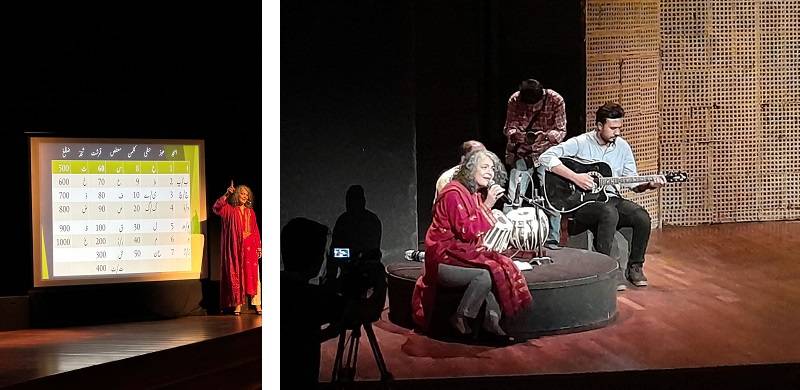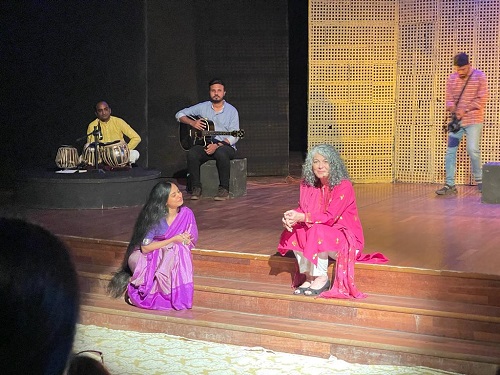
The National Academy of Performing Arts (NAPA) has become a mandatory go-to for cultural entertainment, where you find and network with the literate cream and the social best. In successful continuation, NAPA Talks recently conducted its third session with Romeena Kizilbash Kureishy, who has been teaching Urdu in the United States since 2008. She taught at the University of Pennsylvania STARTALK Urdu Program from 2008-2014 and has been with New York University Hindi-Urdu Teacher Training Institute as an Urdu Pedagogy specialist since 2015. As an Urdu Program Coordinator and Lead Instructor for Kean University’s Global Project-based Learning STARTALK Urdu, she has been spearheading projects and initiatives pertaining to the promotion of language itself, and encouraging its correct usage.
Aptly titled “Urdu Hai Mera Naam” (Urdu is My Name), the talk began with Kulsoom Aftab, a NAPA faculty member, as she walked us through the extensive, treasure trove of experience Kureishy holds. The 90-minute talk was focused on the Urdu language, its evolution, and the histography (Tarikhgoi) of Urdu poetry. In an interactive session, Romeena indulged the audience with questions and responses about the Urdu language. While she emphasized that she is no expert in the subject in question and that her learning process is continuous, she has learned and taught Urdu in the past. She has also taught the ropes of Urdu teaching to local and international teachers.
Like many of us, Kureishy acknowledged that she had taken the Urdu language for granted until she was offered to teach Urdu in a summer program entailing training and workshops. Following that, she was then offered to be a lead Urdu Pedagogy instructor at New York University. Urdu was never offered a grant before in the US for its teachers’ training and development. Under Kureishy’s strong hand, the language was granted, for the first time, approximately US$ 8 million, which was utilised to train teachers and hire top pedagogy experts.
Of course the destination was sweet, but like no easy endeavour, it was riddled with its fair share of challenges. As English has remained the primary language in the US, Urdu pedagogy was conducted in English. However, Kureishy realized the importance of perpetuating the Urdu training in Urdu. “How can we teach Urdu to Urdu teachers in English?” she would ask. Logic prevailed. Before that could happen, she needed to educate herself further in the Urdu language before taking the lead on this. She went back to school after eons and took admission to a Masters’s program in Urdu. For M. Phil in the same, she had to relocate from the US to Pakistan to acquire expertise in tadmeen, arooz, makhtoota shinasi and tanqeed.
While there are many initiatives at a commercial level happening in the major cities of Pakistan, such as the literature festivals and ‘aalmi’ conferences, it is largely, and tragically, divided into two sects. One sect is found at the cultural centres and communities, such as NAPA, while the other sect is populated at Karachi University. And the divide is as platonic as it could be. “Both the sects need to intertwine for a larger purpose to create a transformative and impactful change,” she stressed.
 What was surprising was that the ancestor of the Urdu language emerged from the Aryans about 3,000-3,500 years ago when the Aryans came from western Asia, bringing with them a language that traveled through geography, time and space before it developed into what we call Urdu today. Extrapolating the histography, she explained that Sanskrit was always the language of the elite – the priests and maulvis. According to linguistic experts, Prakrit followed Abranj, before it branched into western Hindi, a twin sister of Urdu, never to be separated from Hindi. The geographical effects separated both.
What was surprising was that the ancestor of the Urdu language emerged from the Aryans about 3,000-3,500 years ago when the Aryans came from western Asia, bringing with them a language that traveled through geography, time and space before it developed into what we call Urdu today. Extrapolating the histography, she explained that Sanskrit was always the language of the elite – the priests and maulvis. According to linguistic experts, Prakrit followed Abranj, before it branched into western Hindi, a twin sister of Urdu, never to be separated from Hindi. The geographical effects separated both.
With a large and surprising chunk to absorb, Romeena intermittently took the stage for musical renderings of Mosey Naina Milai Ke, Mora Saiyaan Mose Bole Na and Hazaron Khwahishen Aisi.
When the British came to reign the subcontinent for good in 1857, they realised they had to learn the local language, for which they built the William College, where works of Arabic and Farsi were translated into Urdu. Before the inception of the said college, Urdu was rendered a difficult language to master. These translations included Bagh-o-Bahar, and later on, Sir Syed Ahmed Khan took upon himself to spearhead his contribution to the language, which birthed the likes of Naumani, Hali, and Nazir Ahmed. Through his essays and mazameen, SSAK addressed the low morale of the Muslims. And what followed was a renaissance of the language itself, brimming with nazms, poetry, ghazals, and kalaams.
The stage was then taken up by Jauhar Abbas, chronogram expert, poet & researcher, who explained the interesting numerology behind the Urdu language and how the years of the incident were coined with words/a combination of words.
“As intricate and beautiful as Urdu is, we treat the language as one used by the second-class citizen, while English remains the one used by the elite. It makes me extremely sad when our own people are not aware of our own treasure. Oftentimes, teachers don’t know about it. We don’t boast PhDs in Urdu. Then, there is also the stigma attached that everything in Urdu is a lot more difficult to comprehend. We must realise that it is not. It is only new. And when you know it, it stops being difficult. The more we appreciate the language, the better we become,” Kureishy mused over a cup of tea. Endorsed.
Aptly titled “Urdu Hai Mera Naam” (Urdu is My Name), the talk began with Kulsoom Aftab, a NAPA faculty member, as she walked us through the extensive, treasure trove of experience Kureishy holds. The 90-minute talk was focused on the Urdu language, its evolution, and the histography (Tarikhgoi) of Urdu poetry. In an interactive session, Romeena indulged the audience with questions and responses about the Urdu language. While she emphasized that she is no expert in the subject in question and that her learning process is continuous, she has learned and taught Urdu in the past. She has also taught the ropes of Urdu teaching to local and international teachers.
Like many of us, Kureishy acknowledged that she had taken the Urdu language for granted until she was offered to teach Urdu in a summer program entailing training and workshops. Following that, she was then offered to be a lead Urdu Pedagogy instructor at New York University. Urdu was never offered a grant before in the US for its teachers’ training and development. Under Kureishy’s strong hand, the language was granted, for the first time, approximately US$ 8 million, which was utilised to train teachers and hire top pedagogy experts.
Of course the destination was sweet, but like no easy endeavour, it was riddled with its fair share of challenges. As English has remained the primary language in the US, Urdu pedagogy was conducted in English. However, Kureishy realized the importance of perpetuating the Urdu training in Urdu. “How can we teach Urdu to Urdu teachers in English?” she would ask. Logic prevailed. Before that could happen, she needed to educate herself further in the Urdu language before taking the lead on this. She went back to school after eons and took admission to a Masters’s program in Urdu. For M. Phil in the same, she had to relocate from the US to Pakistan to acquire expertise in tadmeen, arooz, makhtoota shinasi and tanqeed.
While there are many initiatives at a commercial level happening in the major cities of Pakistan, such as the literature festivals and ‘aalmi’ conferences, it is largely, and tragically, divided into two sects. One sect is found at the cultural centres and communities, such as NAPA, while the other sect is populated at Karachi University. And the divide is as platonic as it could be. “Both the sects need to intertwine for a larger purpose to create a transformative and impactful change,” she stressed.
 What was surprising was that the ancestor of the Urdu language emerged from the Aryans about 3,000-3,500 years ago when the Aryans came from western Asia, bringing with them a language that traveled through geography, time and space before it developed into what we call Urdu today. Extrapolating the histography, she explained that Sanskrit was always the language of the elite – the priests and maulvis. According to linguistic experts, Prakrit followed Abranj, before it branched into western Hindi, a twin sister of Urdu, never to be separated from Hindi. The geographical effects separated both.
What was surprising was that the ancestor of the Urdu language emerged from the Aryans about 3,000-3,500 years ago when the Aryans came from western Asia, bringing with them a language that traveled through geography, time and space before it developed into what we call Urdu today. Extrapolating the histography, she explained that Sanskrit was always the language of the elite – the priests and maulvis. According to linguistic experts, Prakrit followed Abranj, before it branched into western Hindi, a twin sister of Urdu, never to be separated from Hindi. The geographical effects separated both.With a large and surprising chunk to absorb, Romeena intermittently took the stage for musical renderings of Mosey Naina Milai Ke, Mora Saiyaan Mose Bole Na and Hazaron Khwahishen Aisi.
When the British came to reign the subcontinent for good in 1857, they realised they had to learn the local language, for which they built the William College, where works of Arabic and Farsi were translated into Urdu. Before the inception of the said college, Urdu was rendered a difficult language to master. These translations included Bagh-o-Bahar, and later on, Sir Syed Ahmed Khan took upon himself to spearhead his contribution to the language, which birthed the likes of Naumani, Hali, and Nazir Ahmed. Through his essays and mazameen, SSAK addressed the low morale of the Muslims. And what followed was a renaissance of the language itself, brimming with nazms, poetry, ghazals, and kalaams.
The stage was then taken up by Jauhar Abbas, chronogram expert, poet & researcher, who explained the interesting numerology behind the Urdu language and how the years of the incident were coined with words/a combination of words.
“As intricate and beautiful as Urdu is, we treat the language as one used by the second-class citizen, while English remains the one used by the elite. It makes me extremely sad when our own people are not aware of our own treasure. Oftentimes, teachers don’t know about it. We don’t boast PhDs in Urdu. Then, there is also the stigma attached that everything in Urdu is a lot more difficult to comprehend. We must realise that it is not. It is only new. And when you know it, it stops being difficult. The more we appreciate the language, the better we become,” Kureishy mused over a cup of tea. Endorsed.

